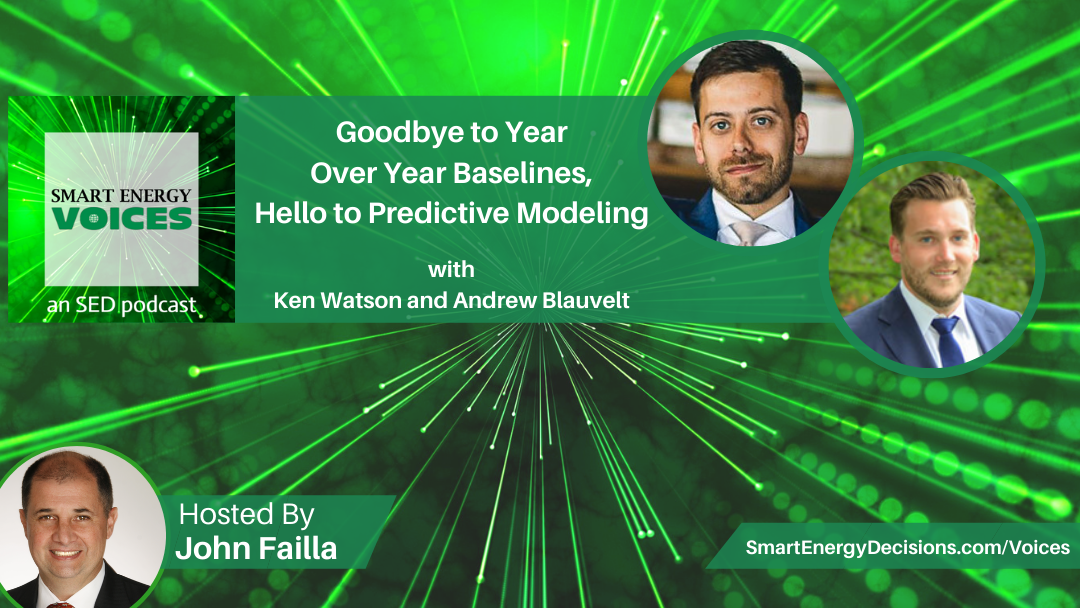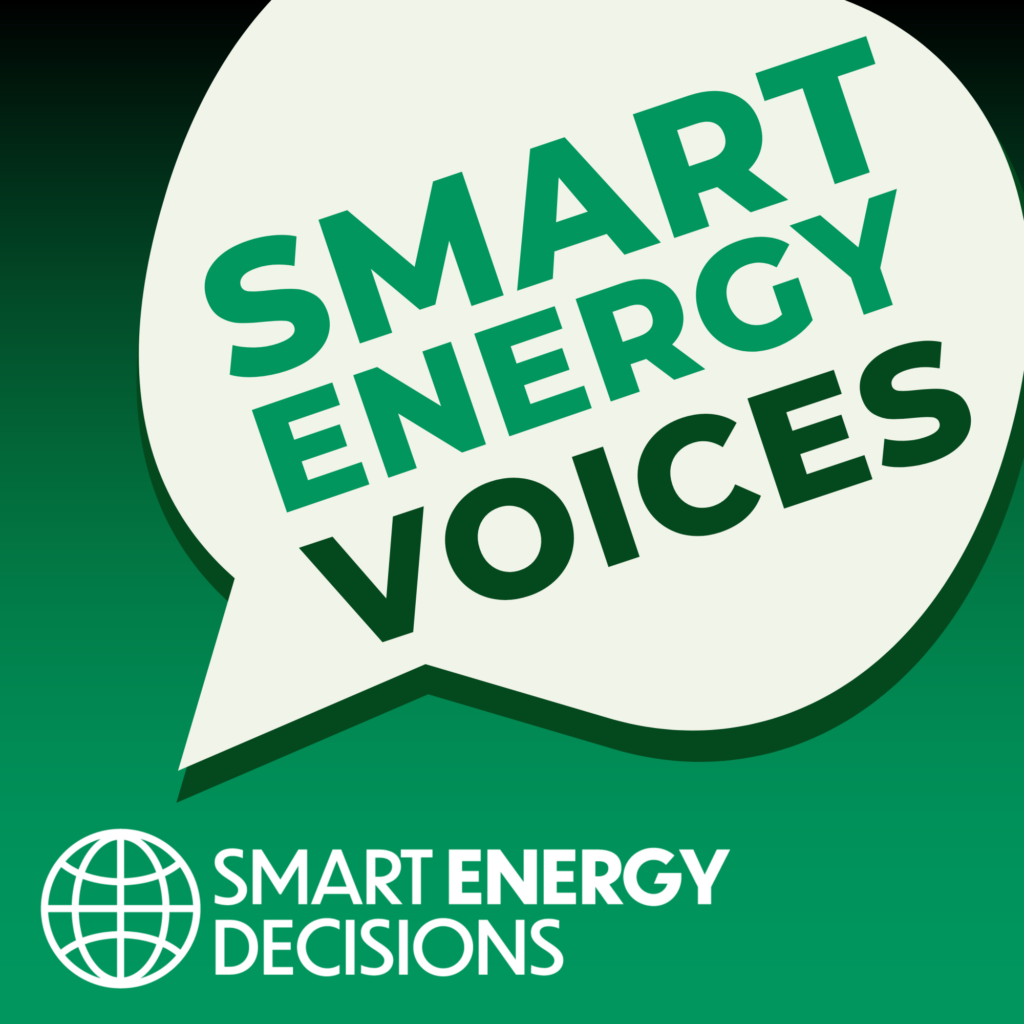Goodbye to Year Over Year Baselines, Hello to Predictive Modeling

Listen on your Preferred Podcast Player »
At a recent Innovation Summit, host Debra Chanil sat down with Ken Watson, a Sr. Manager of Key Accounts at Acuity Brands, and Andrew Blauvelt, the Vice President of Sales at Acuity Brands for the BuildingOS product group. In this episode of Smart Energy Voices, they discuss the shift in building industry energy metrics and establishing baselines in a world with inconsistent occupancy levels and changing public health guidelines. Listen to hear Andrew and Ken share their extensive experience and insight on best practices for navigating this dynamic shift.
You will want to hear this episode if you are interested in…
- Andrew Blauvelt’s and Ken Watson’s roles in their companies [02:02]
- How has 2020 impacted building management? [02:50]
- The solution for last year’s data [05:00]
- Predictive modeling’s role in ensuring health [07:31]
- Resource optimization and new technologies [10:10]
- Occupant engagement dashboarding [11:10]
- Next steps for energy and efficiency managers [11:49]
- Where are companies headed in the coming year? [16:08]
Predictive modeling in response to 2020
Organizations that have used 2020 as a benchmark for climate goals will want to revise their plan for using that year. There were so many variables in 2020 that the data isn’t an accurate representation of what can be expected. COVID-19 has impacted building management in terms of occupancy and energy consumption levels. 2020 usage has skewed the data to the point that it can’t be considered to plan future uses. In addition to COVID, there have been severe weather events throughout the country. The fallout of the pandemic has led to stricter indoor air quality guidelines. Future energy consumption will be increased relative to the past.
Moving forward will require baselines that are established on predictive modeling. Predictive modeling uses real-time data to establish performance baselines essential to helping teams forecast consumption. While corporate sustainability requirements are still a top priority, energy management needs to understand the effects of fluid conditions such as occupancy level, operating hours, and new code requirements.
Involving stakeholders in new technologies
Buyers should engage stakeholders by leveraging the current conditions around indoor air quality requirements, fluctuating baseline models, and the uncertainty of future building operations. The ability to aggregate, normalize, predict, and learn across an enterprise of thousands of buildings should no longer be considered a luxury. These tools are needed now. Occupant safety and awareness are paramount to building necessary trust. Communicating that to the industry will help partners be viewed as pioneers within those respective industries on providing safe and trustworthy spaces. Occupant and stakeholder engagement dashboarding helps create a feedback loop that allows organizations to share things like real-time energy use, project status, green initiatives, and post-COVID improvements that have been made.
How does a company begin to change?
The first step is using the tools that a company already has. In this case, the tool is the air ventilation, bringing more air into a space, flushing out the area, and allowing there to be as much fresh air as possible. The next step is seeing things deeper than airflow, such as particulates, CO2, and VOCs in the air, and then actively managing via alerting and dashboarding how the safe space for your customers is being created. While working that back to sustainability goals, that data can also be used in those predictive models to help you understand the effects of that airflow and new fan energy. The final step is actively comparing those pathogens. Several technologies allow a low-flow UVC to neutralize pathogens up to 99%. These new variables need to be brought back to regression modeling to understand the targets and goals.
For energy and facility managers, the first step should be focusing on low-hanging fruit. Low-cost measures like schedule optimization are an excellent way to get the most out of existing infrastructure. After that, focusing on quick payback projects like an LED retrofit will help get the baseload as low as possible by minimizing capital expense. An ideal end state would be to have an entire portfolio sub-metered and sensored within a single, highly available system. Making adjustments like these, one step at a time, is what will create the energy industry’s needed change.
Resources & People Mentioned
Connect with Ken Watson
- On LinkedIn
Ken Watson is a Sr. Manager of Key Accounts with over 10 years of experience working with enterprise organizations. Ken is an advocate for cloud-based EMIS solutions that enable clients to hit their climate and energy reduction targets using actionable data. His previous experience in managing and procuring energy gives him a deep understanding of the needs building operators have to improve overall energy performance. Prior to his current role as a Senior Manager of Key Accounts at Acuity Brands, Ken worked as a Business Development Manager for Digital Services at Siemens. He’s a Certified Energy Manager and Certified Energy Procurement Professional through the Association of Energy Engineers and a LEED Green Associate. Ken holds a Bachelors of Business Administration/Finance from Illinois
Connect with Andrew Blauvelt
- On LinkedIn
Andrew Blauvelt/is the Vice President of Sales at Acuity Brands for the BuildingOS product group. He works closely with/building owners, operators, consultants and systems integrators to/provide a platform which aggregates, normalizes and benchmarks all building related data.
Andrew believes transparency and collaboration are essential/to unlocking sustainable buildings that close the loop/between owners and occupiers./Andrew/has a strong background in building sciences starting as a/building automation technician, working as an energy engineer for AECOM, managing business development for Siemens in energy services and analytics, and currently/designing a seamless edge to cloud experience at Acuity Brands. Andrew holds a Bachelors in Physics from Albion College, a Bachelors in Materials Science & Engineering from the University of Michigan, and a Masters in Energy Engineering from the University of Illinois at Chicago.
Interested in becoming a Smart Energy Voices Sponsor Partner?
To become a Sponsor Partner of Smart Energy Voices Season 3, please reach out to [email protected] for packages, pricing, and further details.
- Smart Energy Decisions
-
Follow us on LinkedIn
Subscribe to Smart Energy Voices on
Apple Podcasts, Google Podcasts, Android, Spotify, Stitcher, TuneIn Radio, aCast, PlayerFM, iHeart RadioIf you’re interested in participating in the next Smart Energy Decision Event, visit smartenergydecisions.com or email our Community Development team at [email protected]





